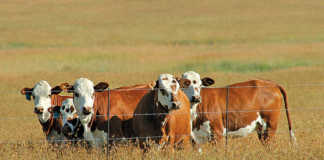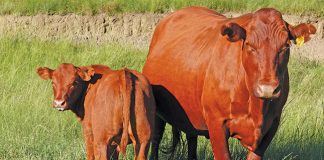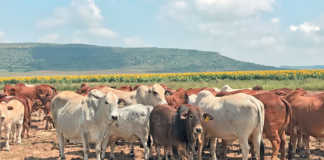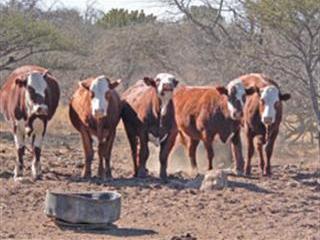
Pieter Schulenburg took over the livestock section of Schulenburg Boerdery from his father Richard 17 years ago. This commercial herd consisted of 250 Brahman and Bonsmara type cattle which his father had established 46 years ago, and were used to produce weaners for the beef market.
The Schulenburgs run a split operation, farming commercial potatoes and cattle on the 9 000ha farm Leeuwfontein near Mogwadi (previously Dendron), about 40km outside Polokwane in Limpopo. Pieter’s brothers, Richard Jnr and Heinrich, manage the crop production while Pieter manages the livestock unit.
Because the cattle operation formed the smaller portion of the Schulenburg enterprise, Pieter looked hard at the quality of the weaners and decided to upgrade the herd genetics to produce animals better suited to the farm’s semi-dry conditions.
The average annual rainfall of the area is 380mm. “Large-framed animals struggle to survive during dry seasons,” says Pieter. After looking at various breed options, he decided on the Braford.
Added value
“The Braford is a medium framed animal that we thought would do well in this area,” he explains. Pieter wanted the best characteristics of the Hereford and the Brahman breeds. “The Brahman has a smooth coat and is hardy and adapted to warm climates with good mothering ability,” he says. From the Hereford he wanted the smaller frame, a top quality carcass and high fertility.
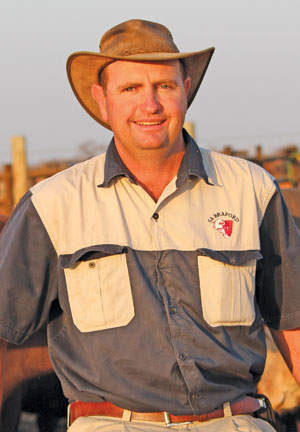
Pieter Schulenberg
The Braford, a composite breed developed from these two pure breeds, is a medium framed animal, well adapted to hot, dry climates with superior maternal ability. “In this low rainfall area, one needs a medium framed animal of between 450kg and 500kg. A heavier animal of 600kg will need more food for maintenance. Lighter framed cows do better on veld during the dry season.
When cows lose condition because of poor veld quality, fertility is affected and reconception rates are low.” From the mixed commercial herd of Bonsmara and Brahman cows, they selected the best cows to cross with Braford bulls. “We upgraded the herd from F1 to F4 with Braford bulls until we had pure-bred Braford cows and we registered the Leeuwfontein Braford Stud in 2000.”
“My aim was to produce good Braford bulls instead of buying in expensive bulls for my commercial herd,” says Pieter. “Bulls born on Leeuwfontein are environmentally fit for the area.” To introduce fresh genetics he occasionally buys in bulls for his stud herd.
On-farm feedlot
There are 250 registered Braford cows and about 450 commercial cows on Leeuwfontein. In 2002, Pieter established a feedlot to add value to his weaners. Weaners from the commercial herd are put through the feedlot. Weaners that don’t make it into the commercial breeding herd are fattened and culled. To keep the feedlot running optimally, Pieter buys in about 150 weaners a week.
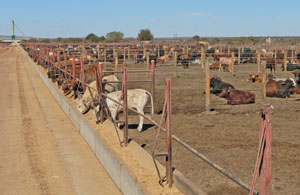
The feedlot with a capacity of over 3 000 cattle was established in 2002 to add value to the Leeuwfontein weaners.
He selects young bulls from the stud herd to service his commercial herd and also sells between 20 and 25 bulls on to fellow breeders and commercial cattlemen who want to produce good weaners for the beef market. “Understandably,” says Pieter, “stud breeders want the best genetics.”
Eliminating weak links
Pieter says there is no room for genetically inferior animals on the farm. “Notions of sentimentality and profitable cattle farming do not mix,” he says. The first selection takes place at weaning. With experience gained over the years, Pieter easily spots poor animals. “If the heifer has a high quarter or something wrong with its legs, I put her through the feedlot.”
The remaining weaners are run on veld for about a year. At about 20 months, heifers and young bulls are brought back in for the next selection.
“This time I look at adaptability,” says Pieter. “I see how the animal has done on veld and if it has managed to look after itself without its mother,” he explains. “Weight maintenance is a good indicator. Animals that show signs of sub-standard adaptability are culled. After that, a breed society selector helps me choose the best for the stud. He’ll probably take out two or three,” says Pieter.
Qualifying heifers are put into the stud herd with two stud bulls. The young bulls join the bull group on the veld until they are three years old, at which stage he sells them. “Because I run the bulls on natural veld, I can guarantee they can maintain and thrive in these conditions,” he explains. Heifers are pregnancy tested when the bulls have been in the herd for 90 days. “Heifers not in calf are culled,” he says.
“Heifers should conceive the first time around. Cows must calve every year.” There is a three-month breeding season. “Cattle cycle every 21 days which gives them three chances to conceive in three months,” explains Pieter. Only about 5% of heifers do not conceive.
“If three or four animals are not pregnant, you know there is nothing wrong with the bull. Heifers not in calf after the breeding cycle are sent to the feedlot. If a greater percentage are not in calf, then you can assume there is something wrong with the bull.”
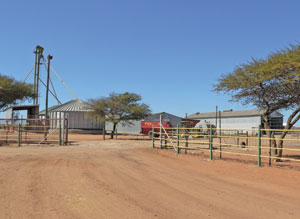
To keep supply to the feedlot animals constant, bought-in feed is stored in these silos.
“After calving, we look at mothering ability,” says Pieter. If the cow does not produce enough milk to wean a calf half her weight, she is culled. A 480kg cow should wean her calf at about 240kg. If I wean 80 heifers, there is a chance we might end up with between 60 and 65 of the original group in four to five years. “But I know these are the best. If a cow is good, but not good enough for the stud herd, I put her into the commercial herd,” explains Pieter.
Summer breeding
Pieter breeds his animals once a year. “I need to learn from other farmers, but establishing what will work for me is important. What works on another farm might not necessarily work here.” Breeding starts in early December and continues until the end of March. Calving starts in September. “Generally, November and February are the high rainfall months and the veld should be in flush by mid-December which makes more food available to freshly calved cows. “We wean in June and July so that there are no calves suckling their mothers during the dry season,” says Pieter.
Veld management
Cattle are reared on the predominantly sweet bushveld. The dominant white buffel grass (Pennisetum pennisetiforme) is a drought tolerant sweet grass, resistant to heavy grazing. The most commonly occurring acacia, Acacia tortillis, sheds nutritious pods which are utilised by cattle. “I allocate 12ha a year to a cow and calf unit,” says Pieter. In summer he plants dryland sorghum which allows him to stretch the grazing and reduce veld utilisation to 9ha/ cow and calf unit for a few months.
The farm is divided into camps of about 70ha to 100ha each, with a watering point supplied by a borehole in each camp.
Cattle graze at a low density of 60 to 65 animals per camp and are rotated every four to five weeks. In summer, Pieter allows a 50% grazing of the sward before moving them to the next camp. “This allows the grass to grow back quicker. In winter I leave them a little longer to graze up to 70% of the grass.“
Learning the lessons
Pieter says that he should have sought the help of experts earlier. “I could have had the specialists in from the beginning to help me select bulls. Buying the wrong bull is a mistake that can take years to correct.” As a breeder, Pieter believes in using the best. “Cutting corners and paying R20 000 less for a bull may leave you with a 10-year problem.” Pieter has learnt to keep his top female breeding material.
“Generally it takes longer to breed with heifers than to buy a cow and a calf or a pregnant cow, but there’s always the risk you are buying someone else’s problems. “I waited too late before I started keeping my own heifers. Had I started earlier, I would have been where I am today five years ago. “But breeding cattle takes time. The next generation will probably enjoy the benefits of what we are doing today.”
Email Pieter Schulenburg at [email protected]











